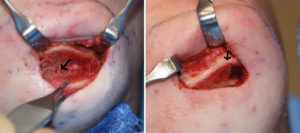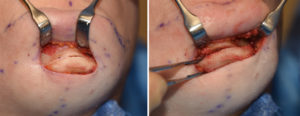Chin reduction is the least commonly performed chin reshaping procedure. This is because how to reduce a large chin is not well known or practiced by most plastic surgeons. While a reverse sliding genioplasty is commonly believed to be an effective chin reduction procedure, it is not. Pushing the bone back with its attached tissues ends up creating increased submental fullness as well a bony bulge along the inferior border of the jawline. Similarly simple burring of the bone from an intraoral approach only reduces its horizontal projection and risks creating soft tissue chin pad ptosis as a result.
The submental approach to chin reduction is a far more effective procedure. The bone can be reduced in any dimension and any excess soft tissue can be reduced at the same time. This is best exemplified when vertical bone height is being reduced along with excess horizontal projection and width. In removing a horizontal wedge of the inferior border of the chin to reduce its height, the cut inferior wedge of bone will have the genioglossus muscle attached. This muscle attachment should not just be cut and released as the bone segment is removed.The retracted muscle can pull downward toward the hyoid and can create increased submental fullness.

Dr. Barry Eppley
Indianapolis, Indiana



